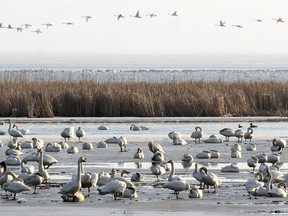Time to target Tundras?

Article content
ST. WILLIAMS - The tundra swan is a tasty bird.
Fortunately for the majestic animal, it is also beautiful to look at.
Tundra swans have come a long way since they were almost hunted out of existence in the early 1900s. They were prized back then for their snowy feathers and savoury flesh.
As many as 80,000 tundra swans will pass through the Long Point flyway this month en route to their summer breeding ground north of the Arctic Circle. The tundra swan population has rebounded so well that some are wondering if it might become a problem for agriculture, winter wheat in particular.
The bird is now so numerous that international wildlife officials are prepared to make 1,200 tags available for an Ontario hunt. The Ministry of Natural Resources, the Canadian Wildlife Service and the Ontario Federation of Anglers & Hunters, however, are reluctant to give their blessing. The reason is a fear of bad publicity.
Dr. Scott Petrie, executive director of Long Point Waterfowl, is the OFAH representative on the committee that makes decisions in this area. Petrie suspects a small but vocal minority would speak out against a tundra swan hunt. Depending on how loud the discussion became, that might undermine the hunting community’s hard-won reputation as stewards of the environment.
“Everyone is pretty much agreed that we have too much to lose and too little to gain by having a tundra swan hunt,” Petrie said. “I know certain people out there would get really upset if we started shooting them. They’re a big majestic bird. We have plenty of things to shoot. We don’t need to start shooting tundra swans.”
Hunting decisions in this area are determined by formulas contained in the Migratory Birds Conventions Act, the treaty between Canada and the United States that regulates the management of species we share in common.
While the Ontario committee is hesitant to declare a tundra swan season, nothing is carved in stone because swan numbers are increasing.
As well, some flocks are lingering in the Long Point area through the winter instead of flying to their traditional wintering ground on Chesapeake Bay. This is happening because winters of late have been milder than usual. There are concerns the swan population might reach the point where it is taking an unacceptable toll on winter wheat, primarily through trampling it.
If it comes to that, it may be necessary to thin their numbers.
“It’s a delicate balancing act to get around the `anti’s’,” says Mike Marques of Langton, chair of the Norfolk chapter of Delta Waterfowl. “You don’t want to step on glass. Most hunters would jump at the chance to hunt a new species. If the population is large enough to have a sustainable hunt, I would be in favour of that.”
Petrie estimates that 10% of hunters would like a tundra swan hunt regardless of public perception while 10% of the general population would be opposed. Anyone bagging a mature tundra swan is looking at a bird weighing about 20 pounds. The swans are all dark meat and would be tough or tender depending on the age of the specimen.
The tundra swan migration through Norfolk reached its peak this week. This past weekend was probably the last for catching a look at the birds in the Port Rowan-Long Point- Port Royal area. Anyone wishing to have a gander over the Easter weekend may have to drive to Grand Bend or Lake St. Claire.